E-Postcard #2
from Our British Isles Holiday
8/25 to 9/15/2002
Cheers!
We are finally able to upload something from our computer via phone connection, so here is our update.
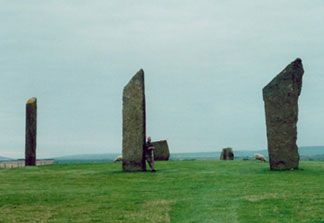
We have completed the first Scotland phase of our trip. We shall be returning in a few weeks and again with our friends Rick and Chris Hamill around Thanksgiving.
The final totals on Scotland are 8 different hostels, 5 different B&Bs, 19 distilleries, 2 island groups, 3 Indian restaurants (plus 1 Italian restaurant and a Burger King), 4 zoos/botanicals garden, 3-6 stone circles/standing stones (depending how you count), 3 Neolithic house/burial sites, numerous castles/palaces/chapels/cathedrals/abbeys/mansions/ruins, some men in skirts and a queen.
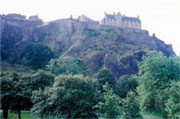
We left London via train for Edinburgh. When I had visited this city 28 years ago, I had a vivid memory of a palace/fortress atop an unassailable hill. It was lighted at night and was the focal point of the city. I had remembered correctly. It is a long but pleasant uphill walk west from the Holyrood Palace built in 1501 to the often attacked Edinburgh castle (first built in the 1100s), a walk called the Royal Mile.
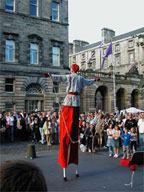 When you look at the other side of the castle, the sheer rock cliff on which it is built helps you see why attempts to capture the castle often failed. During August each year, the Edinburgh Festival is held. This is a collection of classical music, opera, dance, and theatre by internationally known groups. The performances are held at all times of the day and evening. Tickets are very difficult to get. We couldn’t. At the same time, however, is the Fringe Festival. This is about two weeks of concerts, short theatre pieces, and dance by student groups, the hope-to-be-famous, and the used-to-be-famous. We were there for the last day of the Fringe and saw a parody of the James Bond movies done by very funny amateur actors. The zoo, visited the next day, has a large penguin collection. They, too, are very funny to watch but they are professionals.
When you look at the other side of the castle, the sheer rock cliff on which it is built helps you see why attempts to capture the castle often failed. During August each year, the Edinburgh Festival is held. This is a collection of classical music, opera, dance, and theatre by internationally known groups. The performances are held at all times of the day and evening. Tickets are very difficult to get. We couldn’t. At the same time, however, is the Fringe Festival. This is about two weeks of concerts, short theatre pieces, and dance by student groups, the hope-to-be-famous, and the used-to-be-famous. We were there for the last day of the Fringe and saw a parody of the James Bond movies done by very funny amateur actors. The zoo, visited the next day, has a large penguin collection. They, too, are very funny to watch but they are professionals.
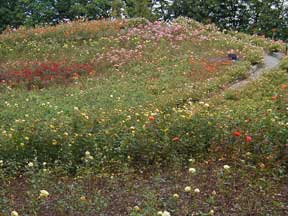
On to Aberdeen, a city thriving on successful North Sea oil exploration. One of the city parks had a garden with literally thousands of rose bushes, many still in bloom. (Patty Klarr, you would love it!). Here we stayed at a wonderful B&B. For breakfast Di ordered Aberdeen Brose (that is oatmeal, cream, honey, and whiskey), so she was in a good mood all day.
Inverness was a rainy city. We stayed in a rundown hostel in the city center. The walk along the river was a restful contrast to the partying most of the night outside our hostel. But Inverness was the place to catch a bus to the Orkney Islands. For those of you who have no idea where those are (and we were among you not too long ago), they are the group of islands to the northeast of mainland Scotland. They were possessions of Norway until the late 1400s and the people still display a proud, independent spirit.
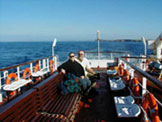
We had no idea what to expect here. The guidebooks had little information about them, claiming only that the Orkneys were treeless and populated mainly by sheep. Not really a glowing recommendation! This is a group of 70 islands (18 inhabited) accessible by ferry. Several of the larger islands are connected by a series of roadways constructed by Italian prisoners of war during WWII. This area was considered a prime site for a German invasion, so was the focus of much interest then. For those of you who can open attachments, there is a photo of us on the Orkney ferry included with this e-postcard.
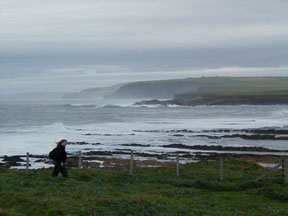
We loved it here. The islands are a delightful mix of very small villages, handmade wool clothing, a 1000 year old cathedral, and surprising ruins. We saw well-preserved ruins of a Neolithic village over 5000 years old. There was also a burial mound from 2700 BC where you could walk inside and see graffiti carved by Viking invaders on the walls 3500 years later, when they looted the place. I find it interesting that we are taught in school about the ancient civilizations of Egypt, Greece, and Rome while ignoring this even older civilization. Although they were not as sophisticated as the aforementioned, they left carvings, jewelry, decorated pottery, and stone circles synchronized to yearly cycles of the sun.
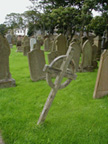
As we drove around, there was a medieval ruin of a monastery and chapel from the 12th century. It was on an island that could only be walked to at low tide. As we walked over and back, we could see the water rising. When we returned later that day, the path to the island was underwater.
It was on the Orkneys that we started the official Distillery Tour (or Whiskey Trail, as the guidebooks call it) with a visit to the Highland Park Distillery. In Scotland, whiskey is what we call scotch whiskey at home. There are many distilleries that make a single malt whiskey. Most of it is blended with other scotches and grain alcohol into names you recognize: Johnny Walker, Dewar’s, Chevas Regal, etc. But each single malt whiskey has a unique taste which depends on the water used, how long the barley is malted (smoked over peat fires), and the shape of the still (always copper). Also, smoothness can depend on whether the new alcohol is aged in old bourbon barrels from the U.S, port/sherry casks from Spain, or a combination. Whiskey was produced in Scotland (we were told) for centuries from the extra barley grown here.
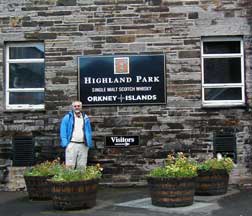 Most production was from illegal stills. The customs agent (tax man) would locate the stills in the mountains from the peat smoke produced. Women would hide copper tubing to make stills under their skirts. Arson, murder, and theft among the bootleggers were not unusual. Eventually, about 100 legal distilleries were left. I know I sound like a tour guide, but Tim did drag me to nineteen of these places. At some we took the full tour, at others we walked around lovely gardens, at all we tasted a “wee dram”. Don’t worry, Moms and Dads, we didn’t do all nineteen on one day!
Most production was from illegal stills. The customs agent (tax man) would locate the stills in the mountains from the peat smoke produced. Women would hide copper tubing to make stills under their skirts. Arson, murder, and theft among the bootleggers were not unusual. Eventually, about 100 legal distilleries were left. I know I sound like a tour guide, but Tim did drag me to nineteen of these places. At some we took the full tour, at others we walked around lovely gardens, at all we tasted a “wee dram”. Don’t worry, Moms and Dads, we didn’t do all nineteen on one day!
Scotland is divided into several whiskey areas, based on location and taste. The eastern and central areas produce a lighter whiskey. As you work your way west across Scotland to the Hebrides (Western Isles), the whiskeys get a heavier, smokier taste from the peat. Some people never like that taste. Both of us found it enjoyable. We learned never to put ice in single malts (it reduces the flavor), to nose (smell) before sipping, and that adding a touch of water brings out the true nature of the whiskey. Since neither of us drinks much at home (believe it or not), these comparative tastings were an interesting process. By the way, if you want the full story of scotch whiskey, ask Tim. He will explain the process (he has many pictures and souvenir glasses to show) and may even pour you a wee dram.
Ah, but I diverse from the itinerary….whiskey will do that to you!
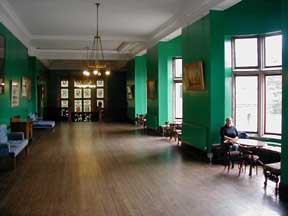
On our way back from the Orkneys we stayed at a hostel that was once a castle (actually a huge mansion). It had a grand staircase with statues, servants’ quarters, and even a resident ghost. The castle overlooks the Kyle of Sutherland in northeast Scotland….mountains, many lochs (lakes), waterfalls…..a beautiful place. The castle is nicknamed “Castle Spite.” The Duchess of Sutherland was the second wife of the Duke. When he died, leaving his estate and castle to her, his first family sued. In settlement, she was given enough money to build another castle, as long as it was not in the “neighborhood”. So she built an even larger castle, visible from the first family’s private railroad route. It included a clock tower, with clocks on every side except where it could be seen by the Duke’s family. The Duchess died before the castle was completed, so she is said to haunt the place, still out of spite.
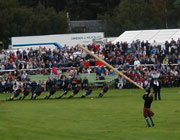
One of the planned highlights of this trip was to be the Braemar Gathering, one of the oldest of the Highland Games. This is essentially a combination of local competition in the morning and national championships in the afternoon. The main events are traditional Scottish displays of manly strength. These included throwing the caber (essentially a small telephone pole) so that it would stand up straight and then fall away from the thrower (good idea). It took one large man to throw it and two to bring it back. Also large round “stones” were tossed for distance. A weight on a chain was twirled around and released. The competitors were all men and all in kilts.
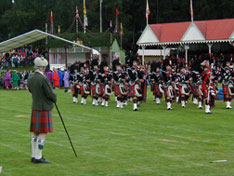 The events were interspersed with children’s sack races, high jumps, footraces, Scottish dancing competition (mostly girls), and the marching in and out of bagpipe and drum bands (all ages). It all took place in an open air stadium, and was akin to a dignified three-ring circus. Since we had the cheap uncovered seats, it rained on/off all day, of course. But we were wearing our rain gear so we didn’t miss a thing. Late in the afternoon, two Land Rovers drove within 20 feet of us into the stadium and out stepped Queen Elizabeth and Prince Phillip. We all stood, sang “God Save the Queen”, she gave her famous regal wave, and sat down in a specially prepared hut decorated with flowers and a grass roof. Then the Games continued as before. What an interesting contrast to security in the U.S.! Most of the men in kilts had ceremonial daggers tucked in their stockings, but the secret service was barely noticeable. And that is likely to be our only contact with the rich and famous on this trip.
The events were interspersed with children’s sack races, high jumps, footraces, Scottish dancing competition (mostly girls), and the marching in and out of bagpipe and drum bands (all ages). It all took place in an open air stadium, and was akin to a dignified three-ring circus. Since we had the cheap uncovered seats, it rained on/off all day, of course. But we were wearing our rain gear so we didn’t miss a thing. Late in the afternoon, two Land Rovers drove within 20 feet of us into the stadium and out stepped Queen Elizabeth and Prince Phillip. We all stood, sang “God Save the Queen”, she gave her famous regal wave, and sat down in a specially prepared hut decorated with flowers and a grass roof. Then the Games continued as before. What an interesting contrast to security in the U.S.! Most of the men in kilts had ceremonial daggers tucked in their stockings, but the secret service was barely noticeable. And that is likely to be our only contact with the rich and famous on this trip.
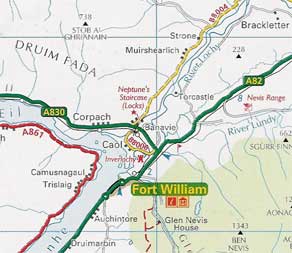
Next was a quick stop in Fort William to not climb Ben Nevis, Britain’s highest peak (we were rained out after ½ hour…I don’t think we were sincere anyway). The weather during this week was always grey in the morning, clearing to light grey in the afternoon. It would sprinkle throughout the day, usually when the locals were telling us how sunny it had been there the day before. Since we had a car, we took a few scenic drives. We were armed with the official Britain Road Guide, which codes roads as A through C for size and green/red/yellow for road condition. The freeways, which are few, are coded M for motorway. Also, the roads are numbered in two, three or four digits...the smaller the number, the more popular the road. Doesn’t that seem logical? Actually, we found that letter, number or color had no relevance at all. A red “A” road could start out as two lanes (double carriageway) right out of town, then change without warning. If we were lucky, the road would then be one and one-half lanes with little areas scooped out on the shoulder. If you saw an oncoming car, you would duck into one of these passing places or hope that the other vehicle did. Such driving was especially exciting if the other vehicle was a large semi (called a lorry) or a full size touring bus. We have great admiration for the bus drivers in Britain…they can guide that baby through a hole in traffic with less than five inches on either side (we’ve seen it!). And then there the roads that were barely one lane and you had to back up to let opposing traffic through. No problem, though, in a few miles it would probably be two lanes with a median. Bridges outside of towns were generally one lane.
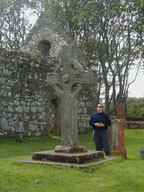
The Hebrides are the islands at the west of Scotland. They are divided into the Inner and Outer Isles, some requiring long and infrequent ferry rides, some uninhabited. We boarded a car ferry early one morning to the small island of Islay (pronounced eye-lay). As with the Orkneys, the guidebooks had very little to say about this island. We found it delightful. The hostel here was small and extremely well kept. Although we only spent one night there, we were able to use it as a starting point to see some wonderful surprises. We found the oldest stone cross in Britain (9th century), the 12th century loch (lake) where the ruler of the Hebrides (called the Lord of the Isles) kept court, a woolen mill that made the tartans for the movie “Braveheart”, and three very fine distilleries. (Since over half the island is peat bog, the distilleries were not that unexpected!) There was also a round church, designed so that the devil could not hide in the corners.
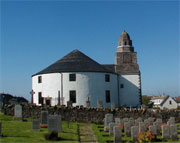 Although one could drive around the main roads in a day, we could have spent longer here exploring the ruins off the beaten path. The journey back on the ferry took us by the island of Jura, which was large, desolate and foreboding, and had only 200 inhabitants. Other islands of the Hebrides include Erraid (the site of Stevenson’s book "Kidnapped", Iona (which claims early Christian settlements from the 6th century and the graves of over 60 kings of Scotland, Ireland, and Norway including the real Macbeth), and Staffa (whose cliffs inspired Mendelssohn’s Hebrides Overture). We will visit the Isle of Skye, another of the Hebrides later on.
Although one could drive around the main roads in a day, we could have spent longer here exploring the ruins off the beaten path. The journey back on the ferry took us by the island of Jura, which was large, desolate and foreboding, and had only 200 inhabitants. Other islands of the Hebrides include Erraid (the site of Stevenson’s book "Kidnapped", Iona (which claims early Christian settlements from the 6th century and the graves of over 60 kings of Scotland, Ireland, and Norway including the real Macbeth), and Staffa (whose cliffs inspired Mendelssohn’s Hebrides Overture). We will visit the Isle of Skye, another of the Hebrides later on.
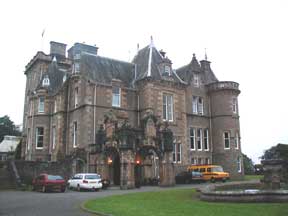
On our way to Glasgow, we stopped overnight to stay at a hostel on Loch Lomond. It was a mansion built in 1860 and given to the YHA (Youth Hostel Association) in the 1940s. It also contained a resident ghost, a girl who jumped to her death from a third story window. As we stayed on the third floor, I didn’t tarry in the halls late at night. I don’t believe in ghosts but I don’t believe in pushing my luck, either. By the way, the song about Loch Lomond that starts “You take the high road and I’ll take the low road…..” was written about war. The high road is returning home from war alive, the low road is being sent home a casualty; the song is not as cheery as I thought originally.
The last Scotland stop was Glasgow. We stayed at huge hostel next to the Clyde River, but within easy walking (or tram distance) of some remarkable museums. All the museums in Glasgow are free! Too bad we only had a Sunday to visit them. The Museum of Modern Art was an old spacious building that displayed some very interesting large works.
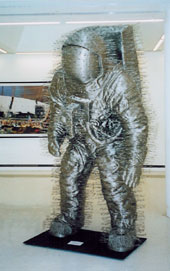 When you walked in, the first thing you saw was a larger-than-life woman diving from the ceiling and leaving a trail of bubbles, all in plastic. This was part of an exhibition by David Mach. He also had several other huge pieces, including a 7 foot tall astronaut made out of thousands of wire coat hangers and masks made of hundreds of match heads. You’ll have to see our pictures, words can’t do these pieces justice.
When you walked in, the first thing you saw was a larger-than-life woman diving from the ceiling and leaving a trail of bubbles, all in plastic. This was part of an exhibition by David Mach. He also had several other huge pieces, including a 7 foot tall astronaut made out of thousands of wire coat hangers and masks made of hundreds of match heads. You’ll have to see our pictures, words can’t do these pieces justice.
Another museum was the St. Mungo Museum of Religious Art. Now there really isn’t a St. Mungo (that’s his nickname) but the museum had an excellent collection of art related to many religions. It was interesting to see how, for example, a Turkish prayer rug had similar features to a Navaho rug or an Australian dreamtime painting. The collection included Salvador Dali’s “Christ of St. John’s Cross”, a famous painting. There was also a comparative collection of how different world religions treated birth, marriage, death, souls, messengers (like angels), and the afterlife. The religions aren’t so different, after all. We really didn’t have the opportunity to give Glasgow the time it deserved. It is a city with beautiful parks, interesting architecture and museums we have yet to explore.
I know this is a long e-postcard, but our infrequent access made it necessary. Hopefully, the next communiqué will be sooner. Hope all of you are well. Take care.
Di and Tim
P.S. Forget about the UK AOL account we mentioned in our last postcard. As it turned out, the British telephone system is easier to use with our U.S. based account, ttdk@aol.com.
 When you look at the other side of the castle, the sheer rock cliff on which it is built helps you see why attempts to capture the castle often failed. During August each year, the Edinburgh Festival is held. This is a collection of classical music, opera, dance, and theatre by internationally known groups. The performances are held at all times of the day and evening. Tickets are very difficult to get. We couldn’t. At the same time, however, is the Fringe Festival. This is about two weeks of concerts, short theatre pieces, and dance by student groups, the hope-to-be-famous, and the used-to-be-famous. We were there for the last day of the Fringe and saw a parody of the James Bond movies done by very funny amateur actors. The zoo, visited the next day, has a large penguin collection. They, too, are very funny to watch but they are professionals.
When you look at the other side of the castle, the sheer rock cliff on which it is built helps you see why attempts to capture the castle often failed. During August each year, the Edinburgh Festival is held. This is a collection of classical music, opera, dance, and theatre by internationally known groups. The performances are held at all times of the day and evening. Tickets are very difficult to get. We couldn’t. At the same time, however, is the Fringe Festival. This is about two weeks of concerts, short theatre pieces, and dance by student groups, the hope-to-be-famous, and the used-to-be-famous. We were there for the last day of the Fringe and saw a parody of the James Bond movies done by very funny amateur actors. The zoo, visited the next day, has a large penguin collection. They, too, are very funny to watch but they are professionals.






 Most production was from illegal stills. The customs agent (tax man) would locate the stills in the mountains from the peat smoke produced. Women would hide copper tubing to make stills under their skirts. Arson, murder, and theft among the bootleggers were not unusual. Eventually, about 100 legal distilleries were left. I know I sound like a tour guide, but Tim did drag me to nineteen of these places. At some we took the full tour, at others we walked around lovely gardens, at all we tasted a “wee dram”. Don’t worry, Moms and Dads, we didn’t do all nineteen on one day!
Most production was from illegal stills. The customs agent (tax man) would locate the stills in the mountains from the peat smoke produced. Women would hide copper tubing to make stills under their skirts. Arson, murder, and theft among the bootleggers were not unusual. Eventually, about 100 legal distilleries were left. I know I sound like a tour guide, but Tim did drag me to nineteen of these places. At some we took the full tour, at others we walked around lovely gardens, at all we tasted a “wee dram”. Don’t worry, Moms and Dads, we didn’t do all nineteen on one day!


 The events were interspersed with children’s sack races, high jumps, footraces, Scottish dancing competition (mostly girls), and the marching in and out of bagpipe and drum bands (all ages). It all took place in an open air stadium, and was akin to a dignified three-ring circus. Since we had the cheap uncovered seats, it rained on/off all day, of course. But we were wearing our rain gear so we didn’t miss a thing. Late in the afternoon, two Land Rovers drove within 20 feet of us into the stadium and out stepped Queen Elizabeth and Prince Phillip. We all stood, sang “God Save the Queen”, she gave her famous regal wave, and sat down in a specially prepared hut decorated with flowers and a grass roof. Then the Games continued as before. What an interesting contrast to security in the U.S.! Most of the men in kilts had ceremonial daggers tucked in their stockings, but the secret service was barely noticeable. And that is likely to be our only contact with the rich and famous on this trip.
The events were interspersed with children’s sack races, high jumps, footraces, Scottish dancing competition (mostly girls), and the marching in and out of bagpipe and drum bands (all ages). It all took place in an open air stadium, and was akin to a dignified three-ring circus. Since we had the cheap uncovered seats, it rained on/off all day, of course. But we were wearing our rain gear so we didn’t miss a thing. Late in the afternoon, two Land Rovers drove within 20 feet of us into the stadium and out stepped Queen Elizabeth and Prince Phillip. We all stood, sang “God Save the Queen”, she gave her famous regal wave, and sat down in a specially prepared hut decorated with flowers and a grass roof. Then the Games continued as before. What an interesting contrast to security in the U.S.! Most of the men in kilts had ceremonial daggers tucked in their stockings, but the secret service was barely noticeable. And that is likely to be our only contact with the rich and famous on this trip.


 Although one could drive around the main roads in a day, we could have spent longer here exploring the ruins off the beaten path. The journey back on the ferry took us by the island of Jura, which was large, desolate and foreboding, and had only 200 inhabitants. Other islands of the Hebrides include Erraid (the site of Stevenson’s book "Kidnapped", Iona (which claims early Christian settlements from the 6th century and the graves of over 60 kings of Scotland, Ireland, and Norway including the real Macbeth), and Staffa (whose cliffs inspired Mendelssohn’s Hebrides Overture). We will visit the Isle of Skye, another of the Hebrides later on.
Although one could drive around the main roads in a day, we could have spent longer here exploring the ruins off the beaten path. The journey back on the ferry took us by the island of Jura, which was large, desolate and foreboding, and had only 200 inhabitants. Other islands of the Hebrides include Erraid (the site of Stevenson’s book "Kidnapped", Iona (which claims early Christian settlements from the 6th century and the graves of over 60 kings of Scotland, Ireland, and Norway including the real Macbeth), and Staffa (whose cliffs inspired Mendelssohn’s Hebrides Overture). We will visit the Isle of Skye, another of the Hebrides later on.

 When you walked in, the first thing you saw was a larger-than-life woman diving from the ceiling and leaving a trail of bubbles, all in plastic. This was part of an exhibition by David Mach. He also had several other huge pieces, including a 7 foot tall astronaut made out of thousands of wire coat hangers and masks made of hundreds of match heads. You’ll have to see our pictures, words can’t do these pieces justice.
When you walked in, the first thing you saw was a larger-than-life woman diving from the ceiling and leaving a trail of bubbles, all in plastic. This was part of an exhibition by David Mach. He also had several other huge pieces, including a 7 foot tall astronaut made out of thousands of wire coat hangers and masks made of hundreds of match heads. You’ll have to see our pictures, words can’t do these pieces justice.